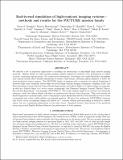End-to-end simulation of high-contrast imaging systems: methods and results for the PICTURE mission family
Author(s)
Douglas, Ewan S.; Hewawasam, Kuravi; Mendillo, Christopher B.; Cahoy, Kerri L; Cook, Timothy A.; Finn, Susanna C. Finn; Howe, Glenn A.; Kuchner, Marc, J.; Lewis, Nikole K.; Marinan, Anne D.; Mawet, Dimitri; Chakrabarti, Supriya; ... Show more Show less
Downloadpreprint (702.7Kb)
Metadata
Show full item recordAbstract
We describe a set of numerical approaches to modeling the performance of spaceflight high-contrast imaging payloads. Mission design for high-contrast imaging requires numerical wavefront error propagation to ensure accurate component specifications. For constructed instruments, wavelength and angle-dependent throughput and contrast models allow detailed simulations of science observations, allowing mission planners to select the most productive science targets. The PICTURE family of missions seek to quantify the optical brightness of scattered light from extrasolar debris disks via several high-contrast imaging techniques: sounding rocket (the Planet Imaging Concept Testbed Using a Rocket Experiment) and balloon flights of a visible nulling coronagraph, as well as a balloon flight of a vector vortex coronagraph (the Planetary Imaging Concept Testbed Using a Recoverable Experiment - Coronagraph, PICTURE-C). The rocket mission employs an on-axis 0.5m Gregorian telescope, while the balloon flights will share an unobstructed off-axis 0.6m Gregorian. This work details the flexible approach to polychromatic, end-to-end physical optics simulations used for both the balloon vector vortex coronagraph and rocket visible nulling coronagraph missions. We show the preliminary PICTURE-C telescope and vector vortex coronagraph design will achieve 10−8 contrast without post-processing as limited by realistic optics, but not considering polarization or low-order errors. Simulated science observations of the predicted warm ring around Epsilon Eridani illustrate the performance of both missions.
Date issued
2015-09Department
Space Telecommunications Astronomy and Radiation (STAR) Lab; Massachusetts Institute of Technology. Department of Aeronautics and AstronauticsPublisher
SPIE
Citation
Douglas, Ewan S., Kuravi Hewasawam, Christopher B. Mendillo, Kerri L. Cahoy, Timothy A. Cook, Susanna C. Finn, Glenn A. Howe, et al. 2015. “End-to-End Simulation of High-Contrast Imaging Systems: Methods and Results for the PICTURE Mission Family.” In Proc. SPIE, 9605:96051A–96051A–13. doi:10.1117/12.2187262.
Other identifiers
10.1117/12.2187262